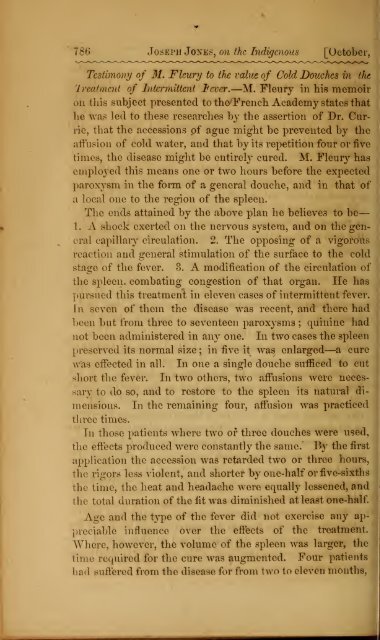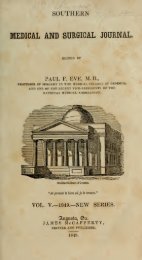18GL]Remedies qfthsp^ Confederacy, 785specially, If \i haw been brought on by violentexercise, the affusion of / cold w^ter in the naked body, oreven immersion in the cold bath, may be hazarded withlittle risk, and sometimes may he resorted to with greatbenefit. After the sweating has continued some time, andMowed freely, -ally if the body lias remained at rest,either the aifusion or immersion is attended with danger,even though the heat of the body at themoment of usingit be greater than natural. Sweating is always a coolingprocess in itself, but in bed it is often prolonged by artificialmeans, and the body prevented from cooling under itto the natural degree by the load of heated clothes.A\ nenthe heat has been thus artificially kept up, a practitioner,judging by the information of his thermometer only, maybe led into error. In this situation the heat sinks rapidlyon the exposure of the surface of the body even to the externalair, and the a<strong>pp</strong>lication of cokl water, either by affusionor immersion, is accompanied by a loss of heat and adeficiency of reaction which are altogether inconsistentwith safety.—Medical Reports, &c. By J. Curry, 1797.According to the experience of Dr. Carrie, if employedon the first or second day with the precautions recommended,the progress of the fever is often checked, but it is sclsafulwhen a<strong>pp</strong>lied so late asthe third or fourthday, though when administered about the eighth or tenthday, or even later, it moderates the symptoms and shortensthe duration of the fever.- More recent observations haveshown, however, that whilst Typhus fever may bethus cutshort, this remedy fails almost universally in arresting Typhoidfever, which runs a definite course and is characterbyas definite pathological alterations, as Scarlet fever,and Small Pox.When the fever has rim on for eight or nine days and thepatient is weak, the heat of tin- water should be only a fewbelow that of the patient, and at this period it ispreferable to sponge the body with cold or tepid vinegarand water.
—786 Joseph Jones, on the Indigenous [<strong>October</strong>,Testimony of M. Fleury to the value of Cold, Douches in thetreatment of Intermittent iever.—M. Fleury in his memoiron this subject presented to the>French Academy states thatlie was led to these researches by the assertionof Dr. Curric,that the accessions of ague might be prevented by theaffusion of cold water, and that by its repetition four or fivetimes, the disease might be entirely cured. M. Fleury hasemployed this means one or two hours before the expectedparoxysm in the form of a general douche, and in that ofa local one to the region of the spleen.The ends attained by the above plan he believes to be1 . A shock exerted on the nervous system, and on the genoralcapillary circulation. 2. The o<strong>pp</strong>osing of a vigorousreaction and general stimulation of the surface to the coldstage of the fever. 3. A modification of the circulation ofthe spleen, combating congestion of that organ. lie haspursued this treatment in eleven cases of intermittent fever.1 1\ seven of them the disease was recent, and there hadbeen but from three to seventeen paroxysms ;quinine hadnot been administered in any one.In two cases the spleenpreserved its normal size ; in five it was enlarged—a curewas effected in all. In one a single douche sufficed to cutshort the fever. In two others, two affusions were necessaryto do so, and to restore to the spleen its natural dimensions.In the remaining four, affusion was practicedthree times.I n those patients where two of three douches were used,the effects produced were constantly the same. By the firsta] (plication the accession was retarded two or three hours,the rigors loss violent, and shorter by one-half or five-sixthsthe time, the heat and headache were equally lessened, andthe total duration of the lit was diminished at least one-half.Age and the type of the fever did not exercise any a<strong>pp</strong>reciableinfluence over the effects of the treatment.Where, however, the volume of the spleen was larger, thetime required for the cure was augmented. Four patientshad Buffered from the disease for from two to eleven months,
- Page 1 and 2: SOUTHERNfttcMcai avto Surgical Imtt
- Page 3 and 4: practical754 i;i'Ji J'oXes, on the
- Page 5 and 6: 756 Joseph Jones, on the Indigenous
- Page 7 and 8: ;7 58 Joseph J ones, on the Indigen
- Page 9 and 10: 760 Joseph Jones, on the Indigenous
- Page 11 and 12: 762 3EPflJoKfis, bn the Indigenous
- Page 13 and 14: 764 Joseph Jones, on the Indigenous
- Page 15 and 16: 7'!
- Page 17 and 18: —'.emeticssbfhJohi[Octobameliorat
- Page 19 and 20: 770 Joseph Jones, on the Indigenous
- Page 21 and 22: 77-? Joseph Jones, on the Indigenou
- Page 23 and 24: 7 74 Joseph Jones, on the Indigenou
- Page 25 and 26: 776 Joseph Jones, on 1 the Indigeno
- Page 27 and 28: 778 Joseph Jones, on the Indigenous
- Page 29 and 30: 780 Joseph Jokes, on (he Indigenous
- Page 31 and 32: 782 Joseph Jones, on the Indigenous
- Page 33: :784 Joseph Jones, on the Indigenou
- Page 37 and 38: 788 Dvphtlima. [October,to confound
- Page 39 and 40: 700 Diphtheria. [October,*almost in
- Page 41 and 42: 792 Diphtheria. [October,in water a
- Page 43 and 44: 704 Diphtheria: [October,find favor
- Page 45 and 46: 796 Diphtheria. [October,tongue. \)
- Page 47 and 48: 798 Uterine Inflammation. October,b
- Page 49 and 50: 800 Uterine Inflammation. [October,
- Page 51 and 52: 802 Uterine Inflammation. [October,
- Page 53 and 54: elhrai804 me Inflammation. [October
- Page 55 and 56: ;806 Phlegmasia Dolens. [October,Th
- Page 57 and 58: SOS Termination ofNerves. [October,
- Page 59 and 60: cl Termination of Nerv October,] to
- Page 61 and 62: —812 Development of Bloodvessels.
- Page 63 and 64: —814 ( orpuscles of the Spleen. [
- Page 65 and 66: —Mi; Ammomcemh. [October,tubes in
- Page 67 and 68: 818 Ammoniamia. [October,v^^%/\yof
- Page 69 and 70: 820 Arnmoniccraia. [October,combine
- Page 71 and 72: 822 Ammonicemia, [October,all, requ
- Page 73 and 74: 824 Galcano Cautery in Cataract. [O
- Page 75 and 76: —826 Editorial. [October,MEDICAL
- Page 77 and 78: ———828 Miscellaneous. [Octobe
- Page 79 and 80: ———830 Miscellaneous. [Octobe
- Page 81: —832 Miscellaneous.was employed f








